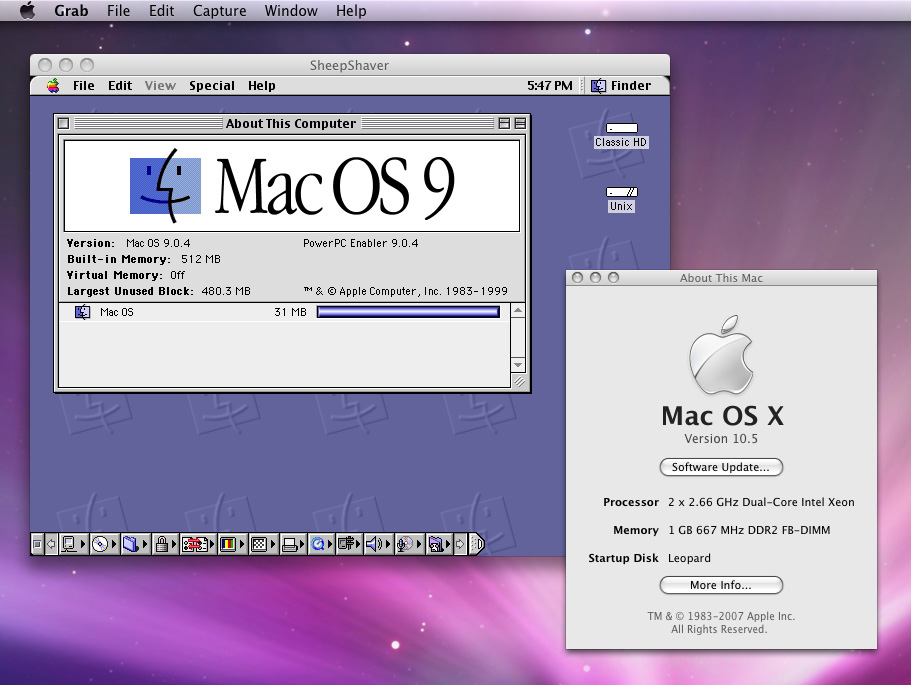

For all Macs that match a specific Mac OS 9 compatibility - courtesy of EveryMac.com's Ultimate Mac Sort- click the compatibility of interest (right column). Please note that 'Classic Mode' indicates a system can run Mac OS 9 applications within the Mac OS X 'Classic Environment' provided with Mac OS X 10.4.11 'Tiger' and lower. Select the 9.2.2 image file you just installed Mac OS 9.2.1 onto. Click on the Start Classic button. Notice that Classic seems to load quicker than it did before (most likely). If asked, update the installation with Classic specific updates. Update your Mac OS 9.2.1 installation on the disk image using previously downloaded system update files. The name 'Classic' is also sometimes used by software vendors to refer to the application programming interface available to 'classic' applications, to differentiate between programming for Mac OS X and the classic version of the Mac OS. The Classic Environment is supported on PowerPC-based Macintosh computers running versions of Mac OS X up to. Mac OS 9.2.2 for PowerMac G4 MDD – Retail Mac OS 9 installers do not work on the last generation PowerMac G4 MDD models. This is a copy of Mac OS 9.2.2 included on the MDD bundled Software Restore CDs which is able to boot these G4 models into OS 9 (FireWire 400 models only). It can also be used as Classic Mode on any PowerMac running Mac OS.
This page is a wiki. Please login or create an account to begin editing.| Rating: | |
| Category: | |
| Year released: | |
| Author: | Apple |
| Publisher: | Apple |

Download Mac Os 9.2.2
os9general.dmg (352.92 MB)
MD5: 36d9c1beb319e98acfa775260e7c3edb
For Mac OS 9
macos9-1-750.jpg

Alternate Download Link: https://amazon.com/gp/drive/.../OS9General.dmg
This is a copy of Mac OS 9.2.2 for the PowerMac G4 MDD. The linked file is an OS X disk image named 'OS9General.dmg' which was contained on the Software Restore CDs bundled with these systems. It includes 'Applications (Mac OS 9)' and 'System Folder'. Unlike retail Mac OS 9 installers, this software is able to boot the PowerMac G4 MDD (FireWire 400 models) into OS 9 or can be used as Classic Mode on any PowerMac running Mac OS X v10.1-10.4. This System includes the Mac OS ROM file v9.6.1.
To use this software to boot an MDD in OS 9, use Disk Utility in Mac OS X (10.1-10.4) to format a hard drive in 'Mac OS Extended' format, and be sure to choose the option to include Mac OS 9 Drivers. Once formatted mount the .dmg file and copy the System and Applications folders from the disk image to the hard drive. Restart your MDD via the Startup System Pref Pane or with the Option key held down, and select your Mac OS 9 drive as the Startup Disk.
For more info see my Vintage Mac Museum Blog: Reinstalling Mac OS 9 on a PowerMac G4 MDD
CompatibilityMac Os 9 Classic Mode Download Windows 10
Architecture: PPC PPC (Carbonized)Boots PowerMac G4 MDD (FireWire 400 models only); should also work for other Mac OS 9 compatible G3 or G4 Mac models. Usable as Classic Mode for all PowerPC Macs running Mac OS X.
(There's no video for Mac OS 9.2.2 for PowerMac G4 MDD yet. Please contribute to MR and add a video now!)
What is Mac OS 9.2.2 for PowerMac G4 MDD? An OS X disk image named 'OS9General.dmg' -- contained on the Software Restore CDs bundled with these systems. It includes 'Applications (Mac OS 9)' and 'System Folder'. Unlike retail Mac OS 9 installers, this software is able to boot the PowerMac G4 MDD (FireWire 400 models) into OS 9 or can be used as Classic Mode on any PowerMac running Mac OS X v10.1-10.4. This System includes the 'Mac OS ROM' file v9.6.1. os9general.dmg(352.92 MiB / 370.06 MB) Mac OS 9 / DMG image 986 / 2014-04-14 / 2019-01-02 / ad2b0b0da1d83726b2e7d9db9ec2eb5f80592b33 / / Architecture
Architecture: PPC 1) Format your hard disk volume with Disk Utility in Mac OS X as 'Mac OS Extended' and make sure to select the option to include Mac OS 9 Drivers. 2) Mount the .dmg file and copy the System and Applications folders from the disk image to the hard drive. 3) Restart your G4 via the Startup System Pref Pane or with the Option key held down, and select your Mac OS 9 drive as the Startup Disk. Emulating this? It should run fine under: SheepShaver |